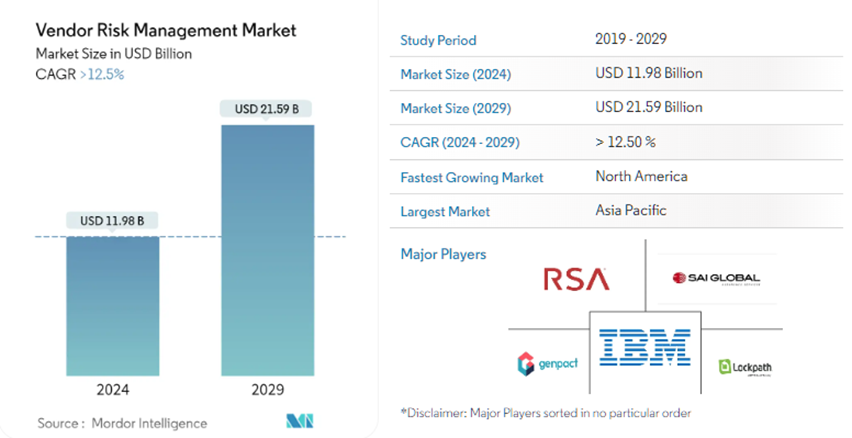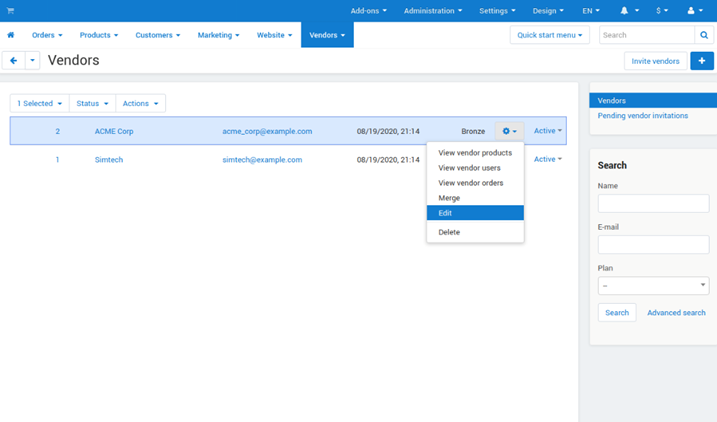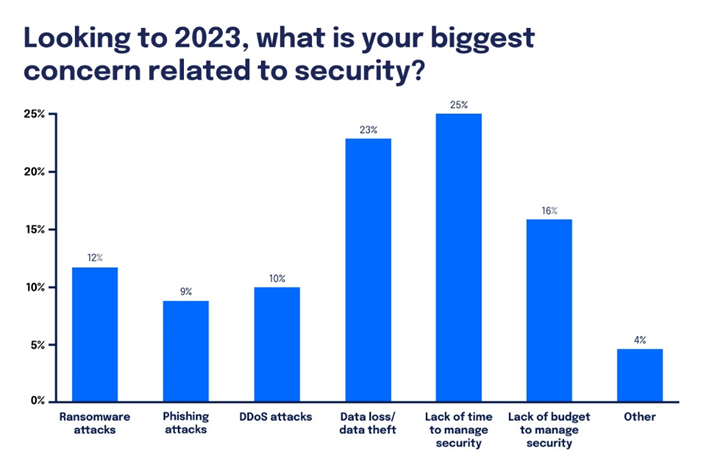8 Key Elements of a Successful Vendor Management Checklist
The global supply chain network has suffered several shocks in recent years—from a pandemic to rising shipping costs and geopolitical tensions—highlighting how unpredictable the procurement process can be.
Today, businesses are much more hawkish when ordering product deliveries. You might spread the risk of a late delivery by making more frequent orders, for example. Or, in the worst case, you may be forced to switch suppliers at short notice.
This increased complexity is good news for the vendor risk management software market, which is set to grow at a CAGR of 12.5% from $11.8 billion in 2024, to $21.59 billion in 2029. However, you should also recognize that minimizing vendor risk takes more than just adopting the right software.
Logistics managers must take a holistic view of their processes; creating contingency plans and a robust network of local and international suppliers.
In this article, we’ll discuss the eight key parts of any successful vendor management checklist that are crucial to minimize disruption in a dynamic logistics environment.

What are the 3 main challenges of vendor management?
Achieving ‘success’ in vendor management means finding an equilibrium between the three core challenges that every supply chain manager faces. Let’s break them down:
- Conducting risk assessments: Due diligence is a core part of the vendor management process — with a wide range of risk factors that must be tracked, such as a supplier’s operational history, track record on regulatory compliance, and wider geopolitical risks. You also need to consider how late or incorrect orders could affect your internal financial risk management.
- Maintaining a steady supply chain: Risk assessments are not infallible, and there’s always a chance that deliveries are delayed, lost, or damaged. These operational risks threaten businesses, especially if you rely on rolling deliveries to fulfill customer orders or manufacture your products.
- Achieving good value for money: Balancing risk and reliability are important, but you cannot compromise on cost. If a vendor’s products are too expensive compared to alternatives, it could price you out of gaining a price edge over your competitors.
8 key elements of a successful vendor management checklist
Struggling to find reliable suppliers and mitigate risk in your supply chain? Keep reading as we guide you through essential steps to enhance your vendor management processes.
1. Streamlining your procurement and purchase order processes
Dealing with purchase orders can be tricky. Think about it: your order ties back to your budget and delivery expectations. And while they are legally binding contracts, a mistake in your wording can translate into receiving a different service than what you expected.
You need a purchase order template that rigorously defines service level expectations and protects your business if things go south. Get your procurement team to stick to these principles during vendor negotiation:
- Clear communication: Ensure all details in your vendor selection and evaluation process are clearly communicated to avoid misunderstandings. If your purchase orders aren’t clear, suppliers might get details wrong — and an error in your vendor contract could mean you have no recourse.
- Rigorous compliance standards: During vendor onboarding, thoroughly check for vendor compliance with your company’s standards. You must ensure that the products/services you’re receiving align with the regulatory environment in which you operate. This is particularly important when dealing with global supply partners based in external jurisdictions.
- Standard payment schedules: Your payment terms need to be on point, as a delay could mean your order being shipped late or canceled entirely. Consider choosing a trusted payment mechanism that will automatically alert your supply chain manager if a transaction is not processed.
2. Adopting a tech stack that helps you track vendor performance
These days, businesses have access to many tools that make for stronger vendor lifecycle management. Get started with these tools to speed up your workflows and more easily spot red flags:
- ETL (Extract, Transform, Load) tools: These tools are fantastic for performing detailed statistical analyses of vendors, helping you understand their financial health and stability. In basic terms, ETL takes data from many different sources, transforms it into a consistent format, and loads it into a database for analysis. This is the first step in any data-driven strategy.
- Compliance tracking software: For industries under tight regulations, like the food sector in the EU, these tools ensure vendors meet all necessary certifications and licenses, contributing to regulatory compliance and vendor risk assessment.
- Vendor performance monitoring systems: Such systems (vendor tracking systems) allow you to monitor delivery times, product quality, and overall vendor reliability. You might want to look for a program that automatically creates vendor assessments or vendor reports for your perusal.

3. Regularly conducting vendor risk assessments
Risk assessment methods are intended to uncover the probability of an order not being fulfilled. Since there are a million things that could go wrong with every order, your assessments should be holistic and look at many types of vendor risk:
- Financial risk: Firstly, consider if the vendor is at risk of bankruptcy, as they may compromise on quality or orders might never appear.
- Operational risk: Do the vendors’ operational capabilities align with the demand from your business?
- Geopolitical risk: Be aware of risks associated with vendors operating in politically unstable regions or shipping lanes.
- Quality risk: Do vendors meet quality standards for their products or services?
- Environmental risk: Do their products align with your sustainability practices? Could there be a backlash from your customers if you breach these goals?
- Compliance risk: Finally, consider that although vendors may fulfill an order, the products may not necessarily comply with legal and regulatory requirements in your area.
Remember, risk assessments are not a one-time event; they’re an ongoing process that alerts you to red flags and allows you to prepare before they become a serious problem.
4. Building strong, mutually beneficial relationships with vendors
Building strong business relationships with your vendors is key to boosting your profitability because it puts you in a better position to negotiate favorable terms. Consider it this way: vendors who trust your business are more likely to prioritize your needs, leading to consistent, high-quality supplies.
So, how do you strengthen these ties?
For starters, regular communication is key. You must inform your vendors about your business goals and expectations. Be open to their feedback, too; as it can provide valuable insights into improving processes. Ensuring timely payments is a given, but try to show appreciation for their services in a personalized message.
Remember, a vendor who feels respected and part of your business is more likely to go the extra mile, and that’s a win-win for everyone.
5. Maintaining a list of alternative suitable vendors
Having a backup list of potential vendors is smart for when things don’t go as planned. You can start this process by searching B2B online directories, attending networking events, or asking for referrals from industry partners.
Don’t think of this as just ticking boxes, you’re trying to find suppliers that truly align with your business’s standards and would be capable of fulfilling your demand over the long term. Regularly updating this list and conducting due diligence through vendor questionnaires will help ensure you have reliable options, maintaining the agility and resilience of your supply chain.

6. Strengthening your security measures with the right software
Cybersecurity risks pose a greater danger to supply chains than ever before, and the right software makes all the difference in preventing them:
- Firewalls and antivirus programs: your first line of defense against cyber threats, blocking unauthorized access to your network.
- Encryption tools: Protect sensitive data during transmission and storage, meaning it cannot be stolen even in the event of a breach.
- Screen share software: Ideal for remote support, this lets your security team troubleshoot issues in real time, enhancing your security posture.
- Network monitoring software: Keeps an eye on network and system health, and provides a control panel for shutting down access to critical data once an incident response is triggered.

7. Ensuring compliance with regulations and legal requirements
In vendor management, the price of non-compliance is extremely high; you could be fined, lose out on new contracts, and suffer damage to your brand image.
To avoid this, you need to look out for major red flags, like vendors appearing on sanctions or law enforcement lists. Pay close attention to their adherence to regulatory agencies and compliance certificates. For instance, a vendor not meeting environmental standards could be a deal-breaker if it doesn’t align with your business’s stated code of ethics.
8. Crafting clear and effective contract management policies
Gone are the days of managing contracts with just spreadsheets. Today’s managers are turning to dedicated contract management platforms that keep all important details and reminders in one place. For instance, you could set up notifications for contract renewals and expirations, and have a centralized repository that shows a timeline of changes to rolling contracts.Your organization should consider using a remote device for daily contract monitoring. That way, your team can check when a delivery is expected to arrive while they’re on the factory floor—no need for a back-and-forth with your office team.

Creating a supply chain that works for your business
To wrap up, vendor management is an essential piece of the supply chain puzzle, and achieving success is difficult in the face of emerging risks.
The first task for supply chain managers is to work out what your main threats are—and to do this, you need to take a holistic view of every single source of risk in the working relationships with your suppliers.
Once you’ve done this, you can take action to prevent hazards, whether it’s creating a list of alternative vendors, a cyber incident response plan, or adopting a compliance tracking system.
As a final word of advice, try to put yourself in a growth mindset where you’re constantly reviewing and aiming to improve your supply chain processes. Vendor management is a cycle, and the one constant is that orders must keep flowing, with little room for error!
Yan Anderson is the Head of Content Marketing at CS-Cart with over 10 years of experience in the eCommerce industry. He's passionate about explaining complicated things in simple terms. Yan has expertise in building, running and growing eCommerce marketplaces. He loves to educate people about best practices, new technologies, and trends in the global eCommerce industry.

